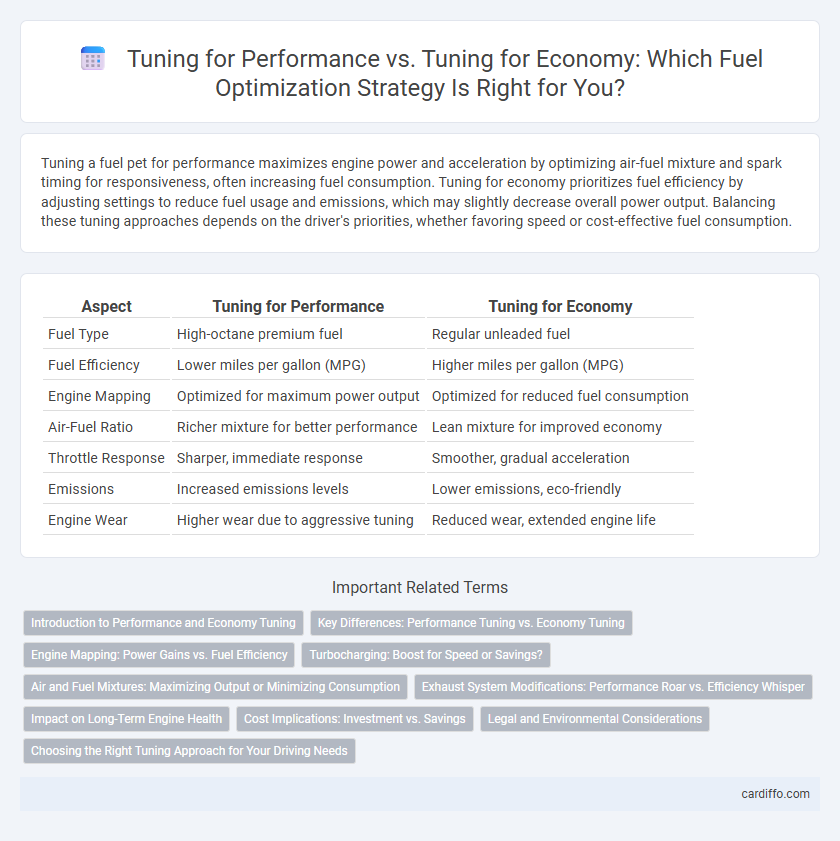Tuning a fuel pet for performance maximizes engine power and acceleration by optimizing air-fuel mixture and spark timing for responsiveness, often increasing fuel consumption. Tuning for economy prioritizes fuel efficiency by adjusting settings to reduce fuel usage and emissions, which may slightly decrease overall power output. Balancing these tuning approaches depends on the driver's priorities, whether favoring speed or cost-effective fuel consumption.
Table of Comparison
| Aspect | Tuning for Performance | Tuning for Economy |
|---|---|---|
| Fuel Type | High-octane premium fuel | Regular unleaded fuel |
| Fuel Efficiency | Lower miles per gallon (MPG) | Higher miles per gallon (MPG) |
| Engine Mapping | Optimized for maximum power output | Optimized for reduced fuel consumption |
| Air-Fuel Ratio | Richer mixture for better performance | Lean mixture for improved economy |
| Throttle Response | Sharper, immediate response | Smoother, gradual acceleration |
| Emissions | Increased emissions levels | Lower emissions, eco-friendly |
| Engine Wear | Higher wear due to aggressive tuning | Reduced wear, extended engine life |
Introduction to Performance and Economy Tuning
Performance tuning focuses on enhancing engine power output and acceleration by optimizing fuel-air mixture, ignition timing, and increasing fuel flow to maximize combustion efficiency. Economy tuning prioritizes fuel efficiency and reduced emissions by calibrating the engine to operate at leaner fuel mixtures and lower RPMs, improving miles per gallon (MPG). Both approaches require precise adjustments to the engine control unit (ECU) for tailored fuel delivery and ignition settings to meet specific driving goals.
Key Differences: Performance Tuning vs. Economy Tuning
Performance tuning focuses on maximizing engine power and acceleration by optimizing fuel delivery, ignition timing, and air intake systems. Economy tuning prioritizes fuel efficiency by adjusting engine parameters to reduce consumption and emissions while maintaining adequate performance for daily driving. Key differences include performance tuning favoring high RPM power gains and economy tuning emphasizing low fuel usage and smoother engine operation.
Engine Mapping: Power Gains vs. Fuel Efficiency
Engine mapping for performance tuning prioritizes maximizing power output by adjusting fuel injection timing and air-fuel ratios, often resulting in increased fuel consumption. In contrast, economy-focused tuning optimizes engine parameters to achieve better fuel efficiency by ensuring leaner mixtures and minimizing unnecessary fuel usage. Balancing power gains with fuel economy requires precise calibration to enhance throttle response without compromising mileage.
Turbocharging: Boost for Speed or Savings?
Turbocharging enhances engine performance by increasing air intake pressure, delivering more power and improved acceleration, ideal for performance tuning. In contrast, turbocharging can be optimized for fuel economy by enabling smaller engines to produce adequate power with better combustion efficiency and reduced fuel consumption. Balancing boost pressure and fuel delivery is crucial to achieve the desired outcome, whether maximizing speed or improving mileage.
Air and Fuel Mixtures: Maximizing Output or Minimizing Consumption
Optimizing air and fuel mixtures plays a crucial role in tuning for performance versus economy, where a richer mixture enhances power output by increasing fuel flow and oxygen intake for combustion. Conversely, a leaner mixture reduces fuel consumption by minimizing excess fuel, thus improving efficiency and lowering emissions. Balancing these mixtures requires precise adjustments to fuel injectors, air intake valves, and engine control units to achieve desired performance or fuel economy goals.
Exhaust System Modifications: Performance Roar vs. Efficiency Whisper
Exhaust system modifications targeting performance tuning prioritize maximizing airflow and reducing backpressure, often resulting in a louder, aggressive exhaust note known as the "performance roar." In contrast, tuning for fuel economy emphasizes optimizing exhaust flow for smoother combustion and minimal energy loss, producing a quieter, more refined "efficiency whisper." Balancing these exhaust characteristics directly impacts fuel consumption and engine responsiveness, highlighting the trade-off between power output and fuel efficiency.
Impact on Long-Term Engine Health
Tuning for performance typically increases fuel delivery and ignition timing to maximize horsepower, which can elevate engine stress and accelerate wear on components like pistons and valves. In contrast, tuning for economy optimizes fuel efficiency by adjusting air-fuel ratios and ignition timing to reduce combustion temperatures and minimize carbon buildup, promoting longer engine life. Balancing performance and economy tuning strategies is essential to maintain optimal long-term engine health while meeting specific fuel consumption goals.
Cost Implications: Investment vs. Savings
Tuning for performance often requires higher-octane fuel and advanced engine modifications, increasing upfront costs but delivering greater horsepower and acceleration. In contrast, tuning for economy focuses on optimizing fuel efficiency and reducing emissions, which lowers fuel expenses over time despite modest initial investment. Balancing investment against potential savings is crucial, as performance tuning may lead to higher ongoing fuel costs, whereas economy tuning prioritizes long-term cost reduction.
Legal and Environmental Considerations
Tuning a vehicle for performance often increases fuel consumption and emissions, potentially violating emission standards set by regulatory bodies like the EPA or Euro 6 norms. In contrast, tuning for economy prioritizes reducing fuel usage and lowering pollutants, ensuring compliance with legal limits on hydrocarbons, nitrogen oxides, and carbon monoxide. Understanding these legal and environmental considerations is crucial to achieving optimal fuel efficiency without risking fines or environmental harm.
Choosing the Right Tuning Approach for Your Driving Needs
Selecting the right tuning approach depends on your primary driving goals, whether maximizing engine power or enhancing fuel efficiency. Performance tuning optimizes fuel delivery and ignition timing to increase horsepower and acceleration, ideal for spirited driving or racing. Economy tuning prioritizes adjusting air-fuel ratios and combustion efficiency to reduce fuel consumption and emissions, suited for daily commuting and long-distance travel.
Tuning for Performance vs Tuning for Economy Infographic

 cardiffo.com
cardiffo.com